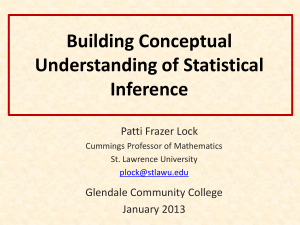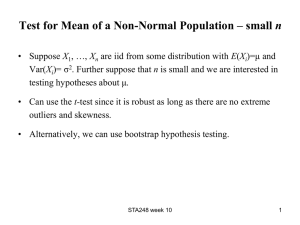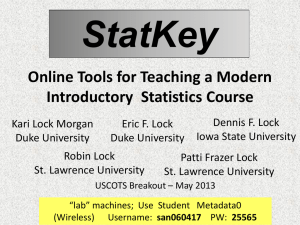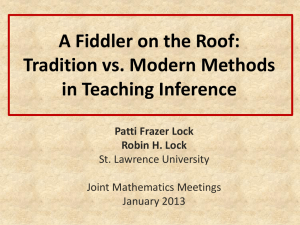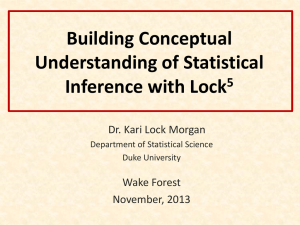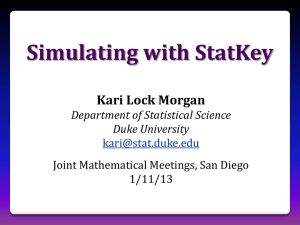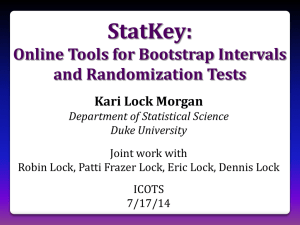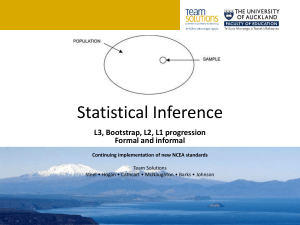- Unlocking the Power of Data
advertisement
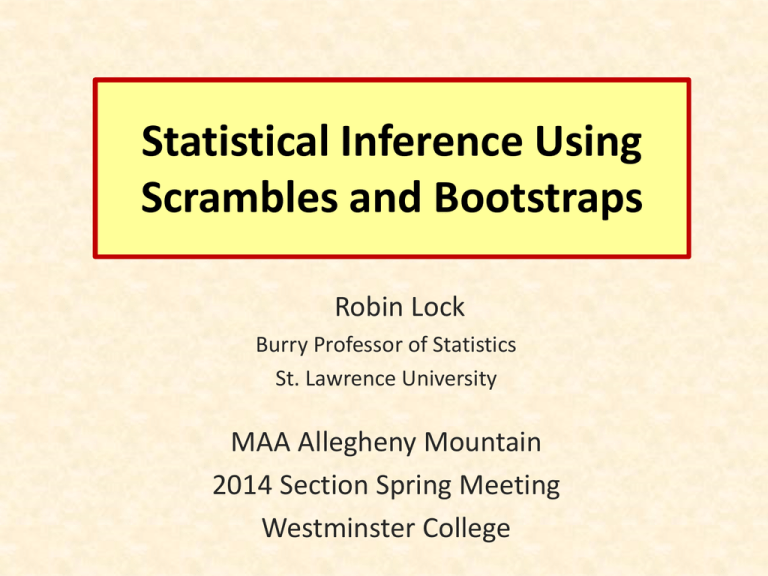
Statistical Inference Using Scrambles and Bootstraps Robin Lock Burry Professor of Statistics St. Lawrence University MAA Allegheny Mountain 2014 Section Spring Meeting Westminster College The Lock5 Team Robin & Patti St. Lawrence Dennis Iowa State Kari Harvard/Duke Eric UNC/Duke/UMinn What is Statistical Inference? Hypothesis Test Is an effect observed in a sample true for a population or just due to random chance? Confidence Interval Based on the data in a sample, find a range of plausible values for a quantity in a population. Example #1: Beer & Mosquitoes • Volunteers were randomly assigned to drink either a liter of beer or a liter of water. • Mosquitoes were caught in nets as they approached each volunteer and counted . Beer Water n mean 25 23.60 18 19.22 Does this provide convincing evidence that mosquitoes tend to be more attracted to beer drinkers or could this difference be just due to random chance? Hypothesis Test Example #2: Mustang Prices • A student selected a random sample of n=25 Mustang (cars) from an internet site and recorded the prices in $1,000’s. Price (in $1,000’s) n Price 25 mean std. dev. 15.98 11.11 Find a range of plausible values where the mean price for all Mustangs at this website is likely to be. Confidence Interval Two Approaches to Inference Traditional: • Assume some distribution (e.g. normal or t) to describe the behavior of sample statistics • Estimate parameters for that distribution from sample statistics • Calculate the desired quantities from the theoretical distribution Simulation: • Generate many samples (by computer) to show the behavior of sample statistics • Calculate the desired quantities from the simulation distribution “New” Simulation Methods? "Actually, the statistician does not carry out this very simple and very tedious process, but his conclusions have no justification beyond the fact that they agree with those which could have been arrived at by this elementary method." -- Sir R. A. Fisher, 1936 Example #1: Beer & Mosquitoes µ = mean number of attracted mosquitoes H0: μB = μW Ha: μB > μW Competing claims about the population means Based on the sample data: 𝑥𝐵 − 𝑥𝑊 = 23.60 − 19.22 = 4.38 Is this a “significant” difference? P-value: The proportion of samples, when H0 is true, that would give results as (or more) extreme as the original sample. Traditional Inference 1. Check conditions 2. Which formula? 𝑡= 𝑥𝐵 − 𝑥𝑊 2 𝑠𝐵2 𝑠𝑊 + 𝑛𝐵 𝑛𝑊 5. Which theoretical distribution? 6. df? 7. Find p-value 8. Interpret a decision 3. Calculate numbers and plug into formula 𝑡= 23.6 − 19.22 2 4.12 3.7 + 18 25 4. Chug with calculator 𝑡 = 3.68 0.0005 < p-value < 0.001 Simulation Approach Number of Mosquitoes Beer 27 20 21 26 27 31 24 19 23 24 28 19 24 29 20 17 31 20 25 28 21 27 21 18 20 Water 21 22 15 12 21 16 19 15 24 19 23 13 22 20 24 18 20 22 Original Sample To simulate samples under H0 (no difference): • Re-randomize the values into Beer & Water groups • Compute 𝑥𝐵 − 𝑥𝑊 𝑥𝐵 = 23.60 𝑥𝑊 = 19.22 𝑥𝐵 − 𝑥𝑊 = 4.38 Simulation Approach Number of Mosquitoes Beer 27 20 21 26 27 31 24 19 23 24 28 19 24 29 20 17 31 20 25 28 21 27 21 18 20 Water 27 20 21 26 27 31 24 19 23 24 28 19 24 29 20 27 31 20 25 28 21 27 21 18 20 21 22 15 12 21 16 19 15 24 19 23 13 22 20 24 18 20 22 21 22 15 12 21 16 19 15 24 19 23 13 22 20 24 18 20 22 To simulate samples under H0 (no difference): 𝑥𝐵 = 23.60 𝑥𝑊 = 19.22 𝑥𝐵 − 𝑥𝑊 = 4.38 Simulation Approach Number of Mosquitoes Beer Water 27 20 20 21 24 26 19 27 20 31 24 24 31 19 13 23 18 24 24 28 25 21 18 15 21 16 28 22 19 27 20 23 22 21 19 24 29 20 27 31 20 25 28 21 27 21 18 20 20 26 21 31 22 19 15 23 12 15 21 22 16 12 19 24 15 29 20 27 21 17 24 28 24 19 23 13 22 20 24 18 20 22 To simulate samples under H0 (no difference): • Re-randomize the values into Beer & Water groups • Compute 𝑥𝐵 − 𝑥𝑊 Repeat this process 1000’s of times to see how “unusual” is the original difference of 4.38. 𝑥𝐵 = 21.76 𝑥𝑊 = 22.50 𝑥𝐵 − 𝑥𝑊 = −0.84 We need technology! StatKey www.lock5stat.com/statkey Freely available web apps with no login required Runs in (almost) any browser (incl. smartphones/tablets) Google Chrome App available (no internet needed) Standalone or supplement to existing technology p-value = proportion of samples, when H0 is true, that are as (or more) extreme as the original sample. p-value Example #2: Mustang Prices Start with a random sample of 25 prices (in $1,000’s) MustangPrice 0 5 Dot Plot 10 15 20 25 Price 30 35 40 𝑛 = 25 𝑥 = 15.98 𝑠 = 11.11 Goal: Find an interval that is likely to contain the mean price for all Mustangs Key concept: How much can we expect the sample means to vary just by random chance? 45 Traditional Inference 1. Check conditions CI for a mean 2. Which formula? 𝑥 ± 𝑧∗ ∙ 𝜎 OR 𝑛 𝑥 ± 𝑡∗ ∙ 𝑠 3. Calculate summary stats 𝑛 = 25, 𝑥 = 15.98, 𝑠 = 11.11 4. Find t* 95% CI 𝛼 5. df? 2 = df=25−1=24 1−0.95 2 = 0.025 t*=2.064 6. Plug and chug 15.98 ± 2.064 ∙ 11.11 25 15.98 ± 4.59 = (11.39, 20.57) 7. Interpret in context 𝑛 Brad Efron Stanford University Bootstrapping “Let your data be your guide.” To create a bootstrap distribution: • Assume the “population” is many, many copies of the original sample. • Simulate many samples from the population by sampling with replacement from the original sample Finding a Bootstrap Sample Original Sample (n=6) A simulated “population” to sample from Bootstrap Sample (sample with replacement from the original sample) Original Sample Bootstrap Sample Repeat 1,000’s of times! 𝑥 = 15.98 𝑥 = 17.51 Original Sample Sample Statistic Bootstrap Sample Bootstrap Statistic Bootstrap Sample Bootstrap Statistic ● ● ● ● ● ● StatKey Bootstrap Sample Bootstrap Statistic Bootstrap Distribution StatKey Standard Error 𝑠 11.114 = = 2.2 𝑛 25 15.98 ± 2 ∙ 2.131 = (11.72, 20.24) A 95% Confidence Level Chop 2.5% in each tail Keep 95% in middle Chop 2.5% in each tail We are 95% sure that the mean price for Mustangs is between $11,800 and $20,190 The same method is used for any statistic, including new statistics that are being defined in areas like genetics. This is very powerful for practioners! (and appreciated by students – especially visual learners) Why does the bootstrap work? Sampling Distribution Population BUT, in practice we don’t see the “tree” or all of the “seeds” – we only have ONE seed µ Bootstrap Distribution What can we do with just one seed? Estimate the distribution and variability (SE) of 𝑥’s from the bootstraps Bootstrap “Population” Grow a NEW tree! 𝑥 µ Use the bootstrap errors that we CAN see to estimate the sampling errors that we CAN’T see. Golden Rule of Bootstraps The bootstrap statistics are to the original statistic as the original statistic is to the population parameter. Example #3: Malevolent Uniforms Do football teams with more malevolent uniforms tend to get more penalty yards? Sample Correlation r = 0.43 H0: ρ = 0 Ha: ρ > 0 Simulation Approach Sample Correlation = 0.43 Find out how extreme this correlation would be, if there is no relationship between uniform malevolence and penalties. i.e., What kinds of results (correlations) would we see, just by random chance? Randomization by Scrambling Original sample 𝑟 = 0.43 Scrambled sample 𝑟 = −0.03 MalevolentUniformsNFL NFLTeam NFL_Ma... ZPenYds <new> 1 LA Raiders 2 Scrambled MalevolentUniformsNFL NFLTeam NFL_Ma... ZPenYds <new> 5.1 1.19 1 LA Raiders Pittsburgh 5 0.48 2 3 Cincinnati 4.97 0.27 4 New Orl... 4.83 5 Chicago 6 5.1 0.44 Pittsburgh 5 -0.81 3 Cincinnati 4.97 0.38 0.1 4 New Orl... 4.83 0.1 4.68 0.29 5 Chicago 4.68 0.63 Kansas ... 4.58 -0.19 6 Kansas ... 4.58 0.3 7 Washing... 4.4 4.4 -0.41 8 St. Louis 4.27 -0.01 8 St. Louis 4.27 -1.6 9 NY Jets 4.12 0.01 9 NY Jets 4.12 -0.07 10 LA Rams 4.1 -0.09 10 LA Rams 4.1 -0.18 11 Cleveland 4.05 0.44 11 Cleveland 4.05 0.01 12 San Diego 4.05 0.27 12 San Diego 4.05 1.19 13 Green Bay 4 -0.73 13 Green Bay 4 -0.19 14 Philadel... 3.97 -0.49 14 Philadel... 3.97 0.27 15 Minnesota 3.9 -0.81 15 Minnesota 16 Atlanta 3.87 0.3 16 17 Indianap... 3.83 -0.19 Repeat 1000’s7 ofWashing... times -0.07 StatKey 3.9 -0.01 Atlanta 3.87 0.02 17 Indianap... 3.83 0.23 18 San Fra... 3.83 0.04 P-value Small p-value Strong evidence of a positive association between uniform malevolence and penalty yards. How does everything fit together? • We use simulation methods to build understanding of the key statistical ideas. • We then cover traditional normal and t-based procedures as “short-cut formulas”. • Students continue to see all the standard methods but with a deeper understanding of the meaning. Intro Stat – Revise the Topics • • •• • • • • Descriptive Statistics – one and two samples Normal distributions Bootstrap confidence intervals Data production (samples/experiments) Randomization-based hypothesis tests Sampling distributions (mean/proportion) Normal distributions Confidence intervals (means/proportions) • Hypothesis tests (means/proportions) • ANOVA for several means, Inference for regression, Chi-square tests Transitioning to Traditional Inference Hypothesis Test: 𝑆𝑎𝑚𝑝𝑙𝑒 𝑆𝑡𝑎𝑡𝑖𝑠𝑖𝑐 − 𝑁𝑢𝑙𝑙 𝑃𝑎𝑟𝑎𝑚𝑒𝑡𝑒𝑟 𝑧= 𝑆𝐸 Confidence Interval: 𝑆𝑎𝑚𝑝𝑙𝑒 𝑆𝑡𝑎𝑡𝑖𝑠𝑡𝑖𝑐 ± 𝑧 ∗ ∙ 𝑆𝐸 The Next Big Thing... “... the consensus curriculum is still an unwitting prisoner of history. What we teach is largely the technical machinery of numerical approximations based on the normal distribution and its many subsidiary cogs. This machinery was once necessary, because the conceptually simpler alternative based on permutations was computationally beyond our reach. Before computers statisticians had no choice. These days we have no excuse. Randomization-based inference makes a direct connection between data production and the logic of inference that deserves to be at the core of every introductory course.” -- Professor George Cobb, 2007 Thanks for listening! rlock@stlawu.edu www.lock5stat.com
